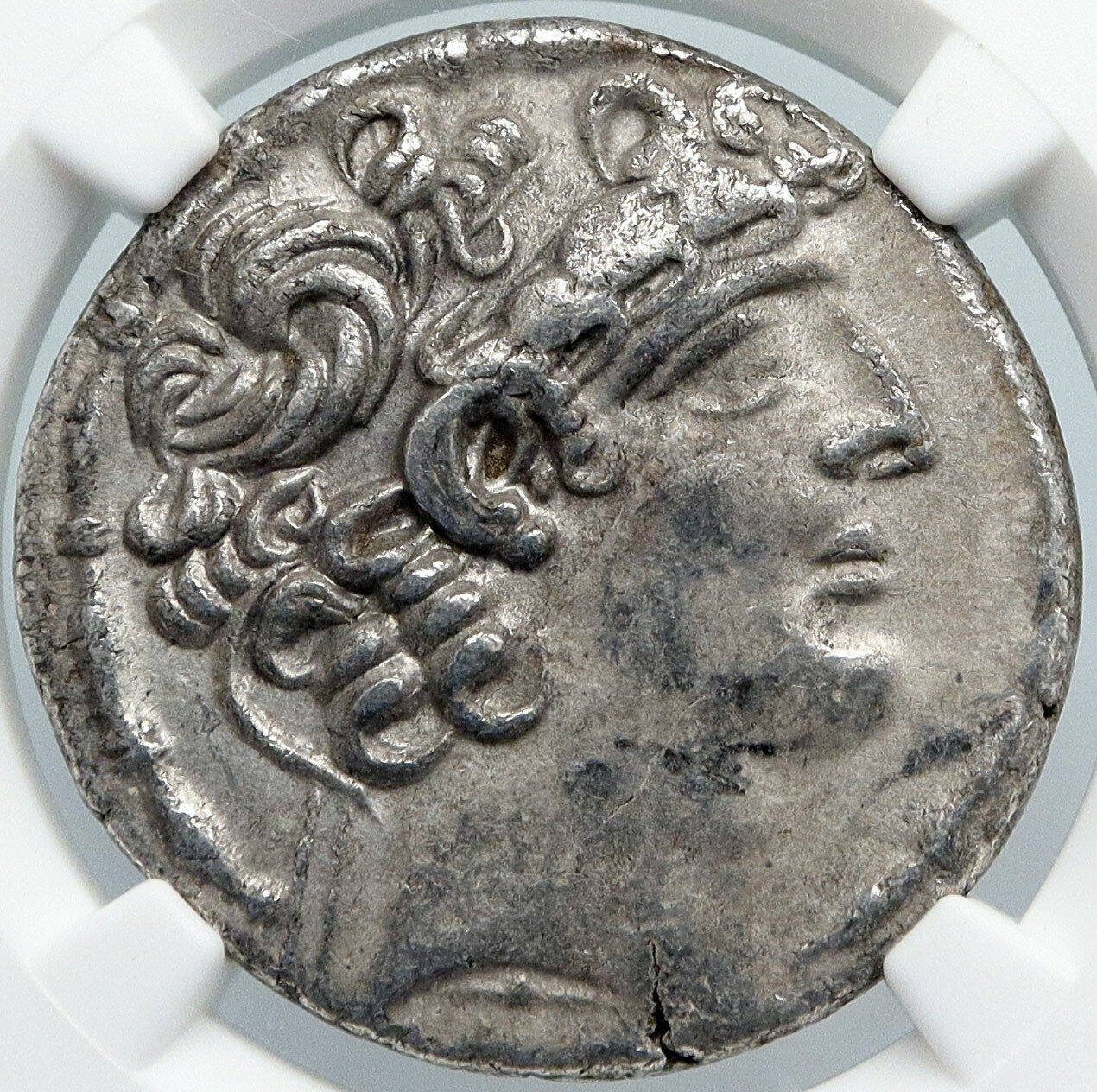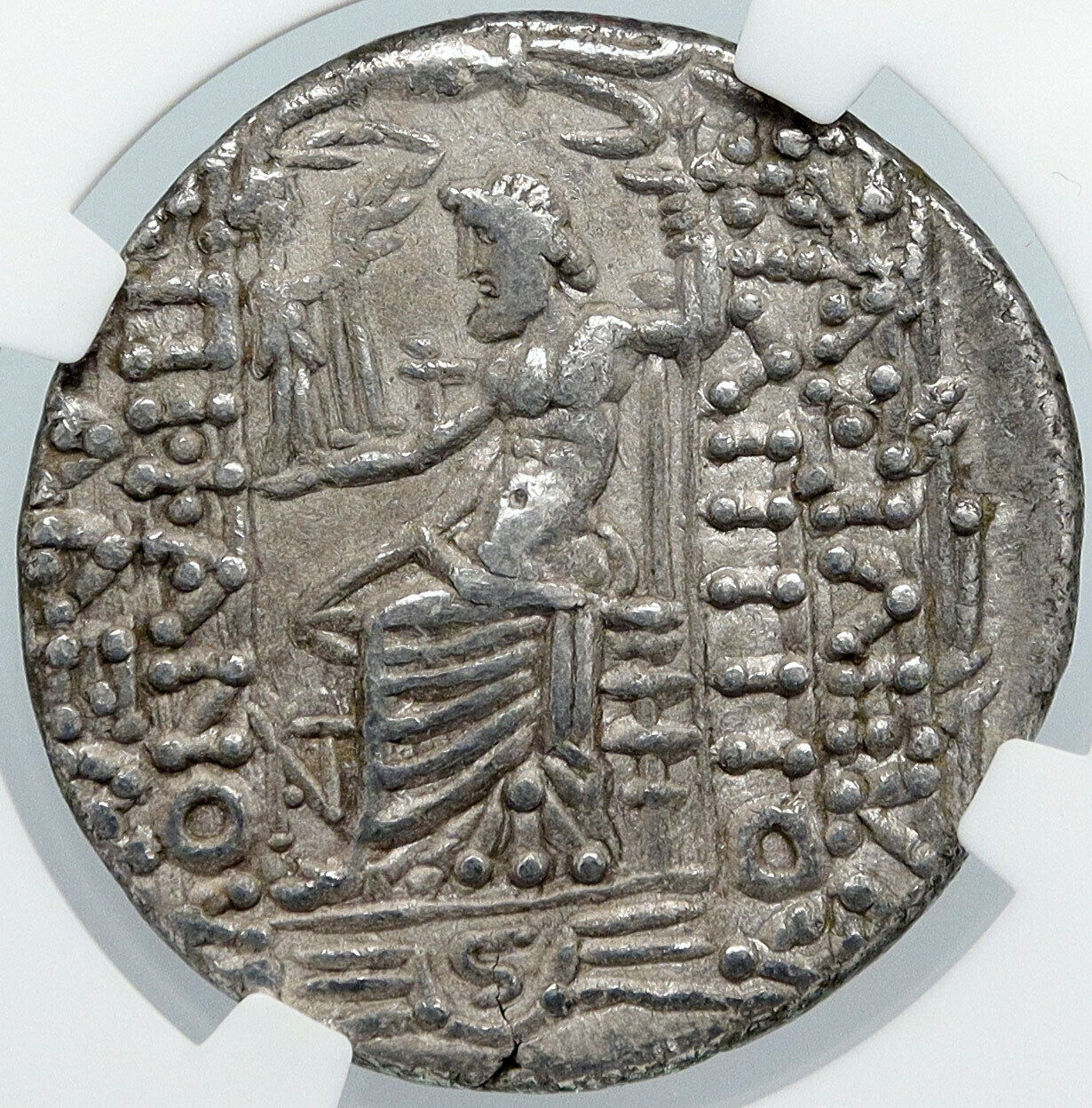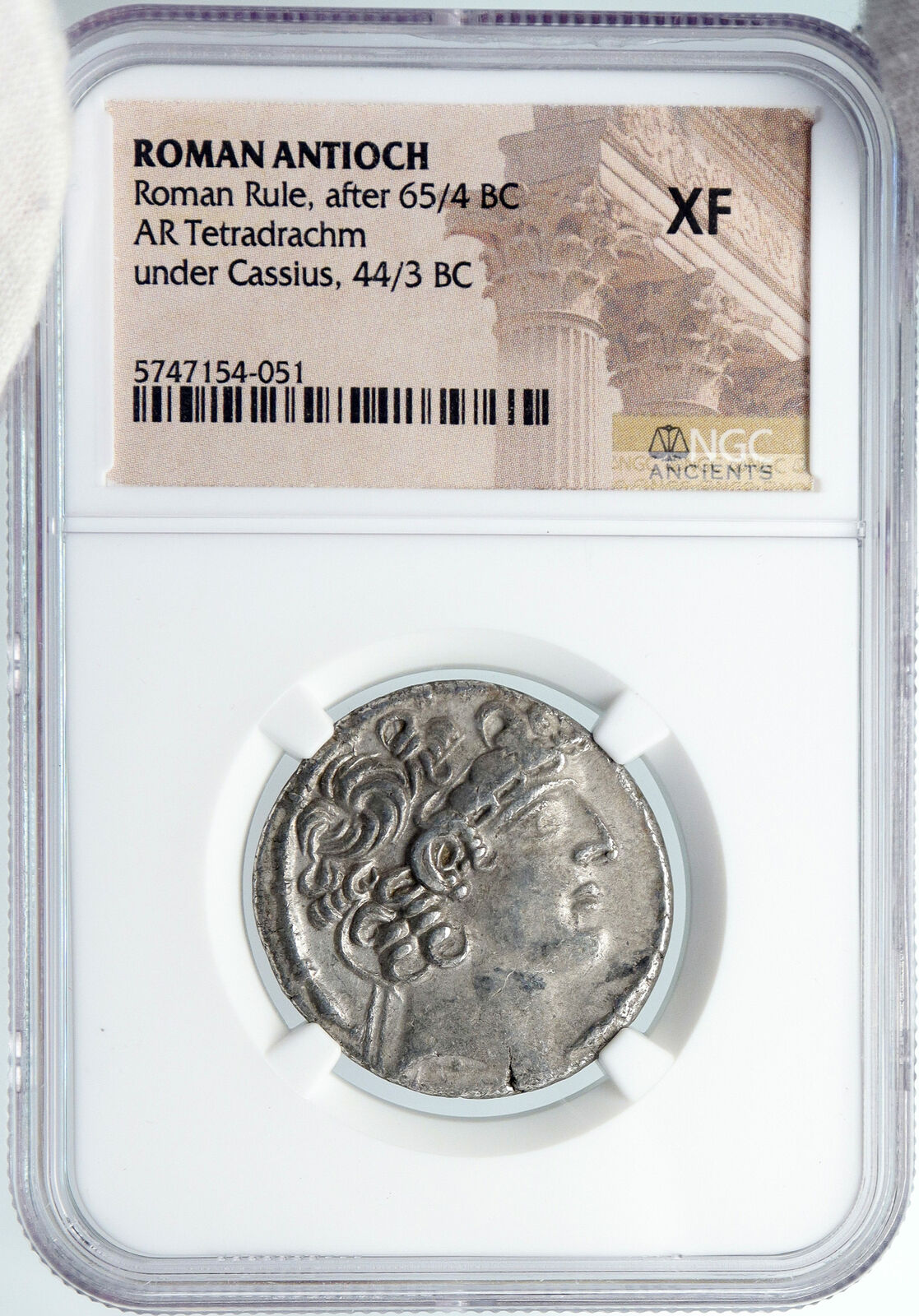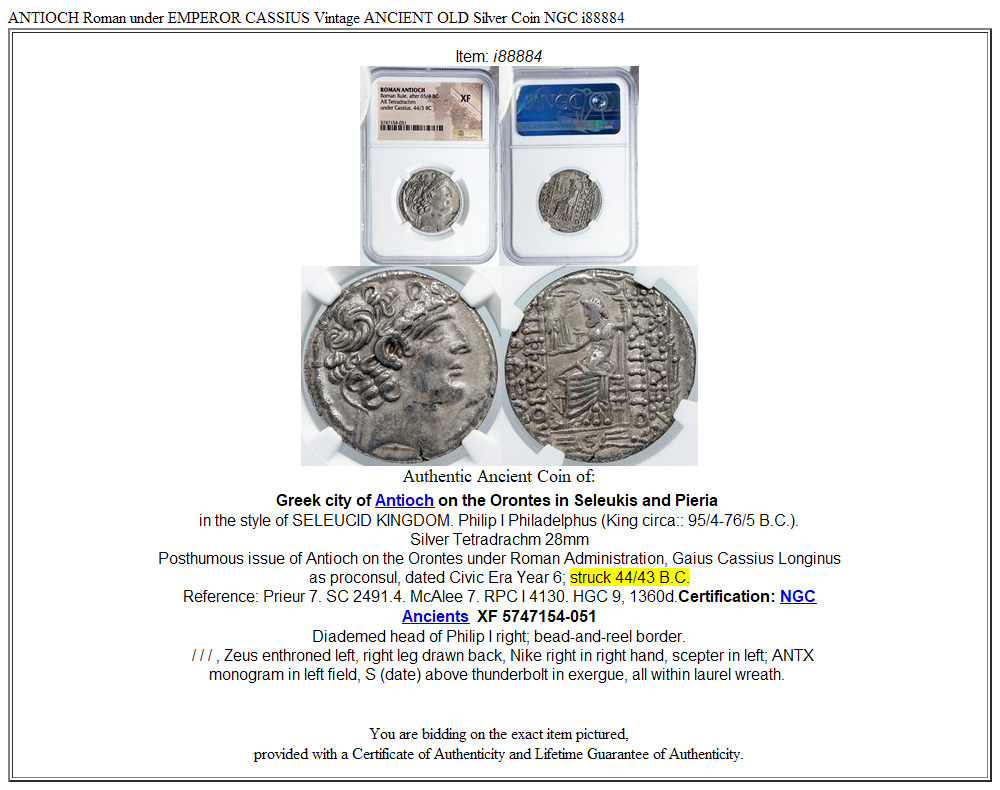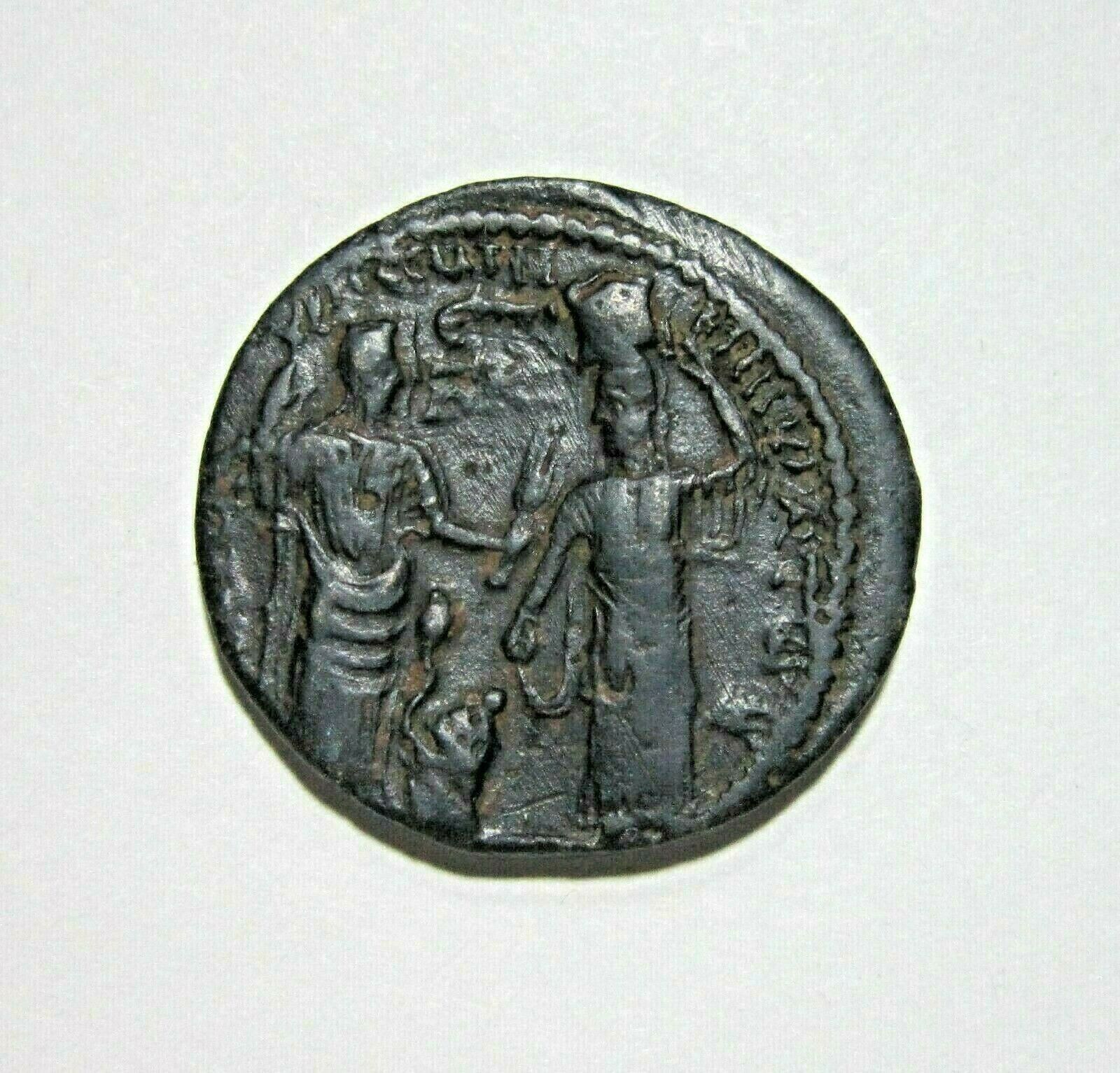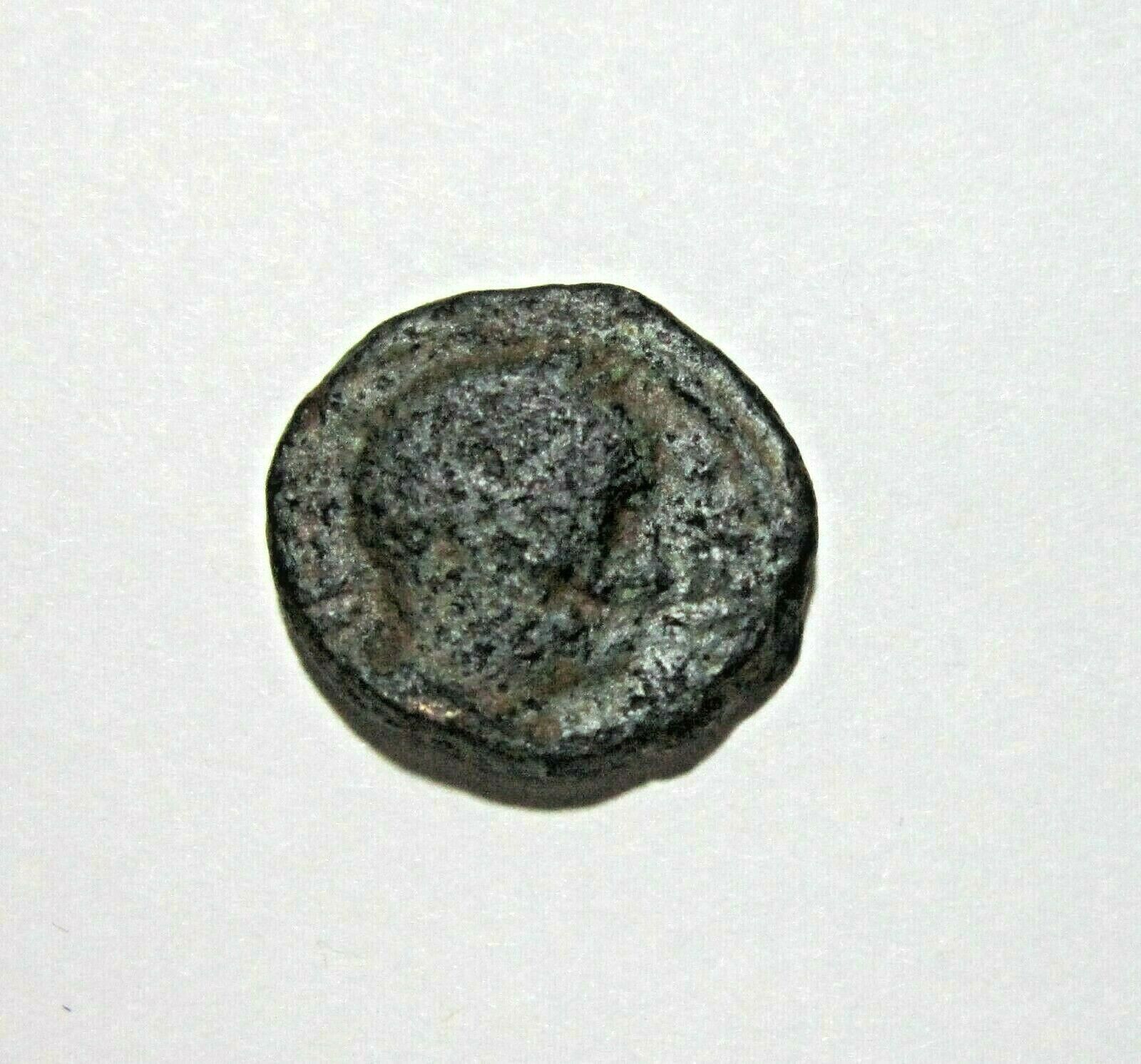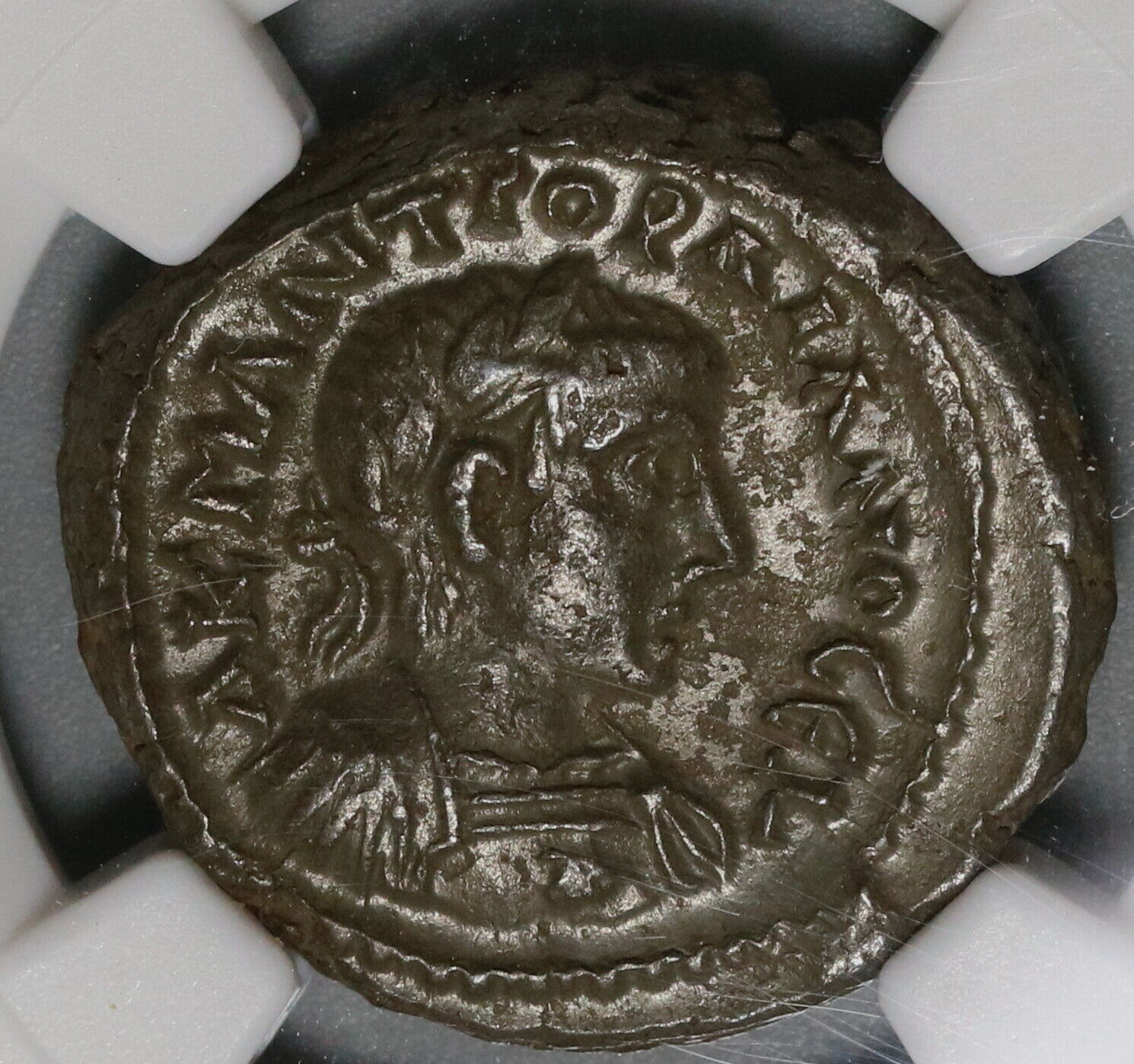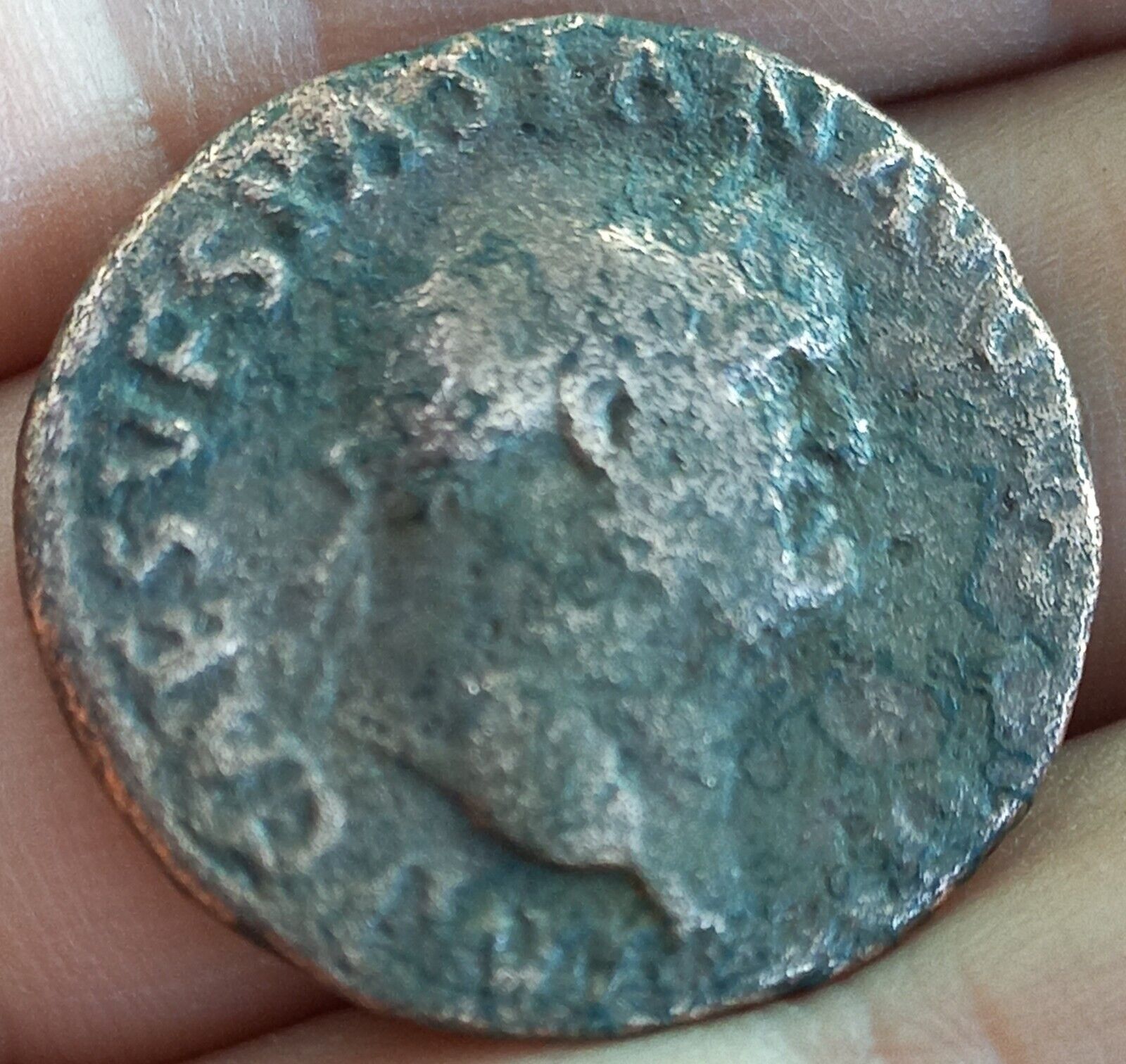-40%
ANTIOCH Roman under EMPEROR CASSIUS Vintage ANCIENT OLD Silver Coin NGC i88884
$ 823.04
- Description
- Size Guide
Description
Item:i88884
Authentic Ancient Coin of:
Greek city of
Antioch
on the Orontes in Seleukis and Pieria
in the style of SELEUCID KINGDOM. Philip I Philadelphus (King circa:: 95/4-76/5 B.C.).
Silver Tetradrachm 28mm
Posthumous issue of Antioch on the Orontes under Roman Administration, Gaius Cassius Longinus as proconsul, dated Civic Era Year 6;
struck 44/43 B.C.
Reference: Prieur 7. SC 2491.4. McAlee 7. RPC I 4130. HGC 9, 1360d.
Certification:
NGC Ancients
XF 5747154-051
Diademed head of Philip I right; bead-and-reel border.
ΒΑΣΙΛΕΩΣ / ΦΙΛΙΠΠΟΥ / ΕΠΙΦΑΝΟΥΣ / ΦΙΛΑΔΕΛΦΟΥ, Zeus enthroned left, right leg drawn back, Nike right in right hand, scepter in left; ANTX monogram in left field, S (date) above thunderbolt in exergue, all within laurel wreath.
You are bidding on the exact item pictured, provided with a Certificate of Authenticity and Lifetime Guarantee of Authenticity.
Founded by Seleukos I circa 300 B.C. with Greek and Macedonian settlers brought from the destroyed city of Antigoneia on the Orontes. The city was named after Seleukos' father with the purpose of being a western capital to guard against the northern expansion of the Ptolemaic kingdom. Eventually as many territories were lost, Antioch became the only capital of the Seleukid kingdom. Pompey the Great deposed the last king Antiochos XIII in 64 B.C. The Romans then made it a capital of a new Roman province and the seat of the Roman governors. There were temples of Olympian Zeus, Apollo in Daphne, hippodrome (built under the Seleukids and embellished by the Romans) and colonnaded main streets (being a gift from Herod the Great). It was an important center for the arts and learning.
Gaius Cassius Longinus
(3 October, c. 86 BC – 3 October 42 BC), often referred to as simply
Cassius
, was a Roman senator and general best known as a leading instigator of the plot to assassinate Julius Caesar on March 15, 44 BC. He was the brother-in-law of Brutus, another leader of the conspiracy. He commanded troops with Brutus during the Battle of Philippi against the combined forces of Mark Antony and Octavian, Caesar's former supporters, and committed suicide after being defeated by Mark Antony.
Cassius was elected as a Tribune of the Plebs in 49 BC. He opposed Caesar, and eventually he commanded a fleet against him during Caesar's Civil War: after Caesar defeated Pompey in the Battle of Pharsalus, Caesar overtook Cassius and forced him to surrender. After Caesar's death, Cassius fled to the East, where he amassed an army of twelve legions. He was supported and made Governor by the Senate. Later he and Brutus marched west against the allies of the Second Triumvirate.
He followed the teachings of the philosopher Epicurus, although scholars debate whether or not these beliefs affected his political life. Cassius is a main character in William Shakespeare's play
Julius Caesar
that depicts the assassination of Caesar and its aftermath. He is also shown in the lowest circle of Hell in Dante's
Inferno
as punishment for betraying and killing Caesar.
Gaius Cassius Longinus (
Classical Latin:
.ʊs ˈlɔŋɡɪnʊs) came from a very old Roman family, gens Cassia, which had been prominent in Rome since the 6th century BC. Little is known of his early life, apart from a story that he showed his dislike of despots while still at school, by quarreling with the son of the dictator Sulla. He studied philosophy at Rhodes under Archelaus of Rhodes and became fluent in Greek. He was married to Junia Tertia, who was the daughter of Servilia and thus a half-sister of his co-conspirator Brutus. They had one son, who was born in about 60 BC.
In 54 BC, Cassius joined Marcus Licinius Crassus in his eastern campaign against the Parthian Empire. In 53 BC, Crassus suffered a decisive defeat at the Battle of Carrhae in Northern-Mesopotamia losing two-thirds of his army. Cassius led the remaining troops' retreat back into Syria, and organized an effective defense force for the province. Based on Plutarch's account, the defeat at Carrhae could have been avoided had Crassus acted as Cassius had advised. According to Dio, the Roman soldiers, as well as Crassus himself, were willing to give the overall command to Cassius after the initial disaster in the battle, which Cassius "very properly" refused. The Parthians also considered Cassius as equal to Crassus in authority, and superior to him in skill.
In 51 BC, Cassius was able to ambush and defeat an invading Parthian army under the command of prince Pacorus and general Osaces. He first refused to do battle with the Parthians, keeping his army behind the walls of Antioch (Syria's most important city) where he was besieged. When the Parthians gave up the siege and started to ravage the countryside, he followed them with his army harrying them as they went. The decisive encounter came on October 7th as the Parthians turned away from Antigonea. As they set about their return journey they were confronted by a detachment of Cassius' army, which faked a retreat and lured the Parthians into an ambush. The Parthians were suddenly surrounded by Cassius' main forces and defeated. Their general Osaces died from his wounds, and the rest of the Parthian army retreated back across the Euphrates.
Cassius returned to Rome in 50 BC, when civil war was about to break out between Julius Caesar and Pompey. Cassius was elected tribune of the Plebs for 49 BC, and threw in his lot with the Optimates, although his brother Lucius Cassius supported Caesar. Cassius left Italy shortly after Caesar crossed the Rubicon. He met Pompey in Greece, and was appointed to command part of his fleet.
In 48 BC, Cassius sailed his ships to Sicily, where he attacked and burned a large part of Caesar's navy. He then proceeded to harass ships off the Italian coast. News of Pompey's defeat at the Battle of Pharsalus caused Cassius to head for the Hellespont, with hopes of allying with the king of Pontus, Pharnaces II. Cassius was overtaken by Caesar en route, and was forced to surrender unconditionally.
Caesar made Cassius a legate, employing him in the Alexandrian War against the very same Pharnaces whom Cassius had hoped to join after Pompey's defeat at Pharsalus. However, Cassius refused to join in the fight against Cato and Scipio in Africa, choosing instead to retire to Rome.
Cassius spent the next two years in office, and apparently tightened his friendship with Cicero. In 44 BC, he became
praetor peregrinus
with the promise of the Syrian province for the ensuing year. The appointment of his junior and brother-in-law, Marcus Brutus, as
praetor urbanus
deeply offended him.
Although Cassius was "the moving spirit" in the plot against Caesar, winning over the chief assassins to the cause of tyrannicide, Brutus became their leader. On the Ides of March, 44 BC, Cassius urged on his fellow liberators and struck Caesar in the chest. Though they succeeded in assassinating Caesar, the celebration was short-lived, as Mark Antony seized power and turned the public against them. In letters written during 44 BC, Cicero frequently complains that Rome was still subjected to tyranny, because the "Liberators" had failed to kill Antony. According to some accounts, Cassius had wanted to kill Antony at the same time as Caesar, but Brutus dissuaded him.
Cassius' reputation in the East made it easy to amass an army from other governors in the area, and by 43 BC, he was ready to take on Publius Cornelius Dolabella with 12 legions. By this point, the Senate had split with Antonius, and cast its lot with Cassius, confirming him as governor of the province. Dolabella attacked but was betrayed by his allies, leading him to commit suicide. Cassius was now secure enough to march on Egypt, but on the formation of the Second Triumvirate, Brutus requested his assistance. Cassius quickly joined Brutus in Smyrna with most of his army, leaving his nephew behind to govern Syria.
The conspirators decided to attack the triumvirate’s allies in Asia. Cassius set upon and sacked Rhodes, while Brutus did the same to Lycia. They regrouped the following year in Sardis, where their armies proclaimed them imperator. They crossed the Hellespont, marched through Thrace, and encamped near Philippi in Macedon. Gaius Julius Caesar Octavian (later known as Augustus) and Mark Antony soon arrived, and Cassius planned to starve them out through the use of their superior position in the country. However, they were forced into a pair of battles by Antony, collectively known as the Battle of Philippi. Brutus was successful against Octavian, and took his camp. Cassius, however, was defeated and overrun by Antony and, unaware of Brutus' victory, gave up all hope and killed himself with the very same dagger he had used against Julius Caesar. The date of Cassius' death is the same as that of his birth, October 3. He was mourned by Brutus as "the Last of the Romans" and buried in Thassos.
Frequently Asked Questions
Mr. Ilya Zlobin
, world-renowned expert numismatist, enthusiast, author and dealer in authentic ancient Greek, ancient Roman, ancient Byzantine, world coins & more.
Who am I dealing with?
You are dealing with Ilya Zlobin, ancient coin expert, enthusiast, author and dealer with an online store having a selection of over 15,000 items with great positive feedback from verified buyers and over 10 years experience dealing with over 57,000 ancient and world coins and artifacts. Ilya Zlobin is an independent individual who has a passion for coin collecting, research and understanding the importance of the historical context and significance all coins and objects represent. Most others are only concerned with selling you, Ilya Zlobin is most interested in educating you on the subject, and providing the largest selection, most professional presentation and service for the best long-term value for collectors worldwide creating returning patrons sharing in the passion of ancient and world coin collecting for a lifetime.
How long until my order is shipped?
Orders are shipped by the next business day (after receipt of payment) most of the time.
How will I know when the order was shipped?
After your order has shipped, you will be left positive feedback, and that date could be used as a basis of estimating an arrival date. Any tracking number would be found under your 'Purchase history' tab.
USPS First Class mail takes about 3-5 business days to arrive in the U.S. International shipping times cannot be estimated as they vary from country to country.
Standard international mail to many countries
does not
include a tracking number, and can also be slow sometimes.
For a tracking number and signature confirmation, you may want to do Express Mail International Shipping, which costs more, however, is the fastest and most secure. Additionally you may be able to receive your order in as little as 3-5 business days using this method. For Express Mail International, it may be possible to place up to 10-15 items in one package (for the one shipping cost) as it is flat rate envelope, which may be the most cost-effective, secure and fastest way to receive items internationally. Send me a message about this and I can update your invoice should you want this method.
Getting your order to you, quickly and securely is a top priority and is taken seriously here.
Great care is taken in packaging and mailing every item securely and quickly.
Please be aware, I cannot take responsibility for any postal service delivery delays, especially for international packages as it may happen in rare instances.
What is a certificate of authenticity and what guarantees do you give that the item is authentic?
Each of the items sold here, is provided with a Certificate of Authenticity, and a Lifetime Guarantee of Authenticity, issued by a world-renowned numismatic and antique expert that has identified over 57,000 ancient coins and has provided them with the same guarantee. You will be very happy with what you get with the COA; a professional presentation of the coin, with all of the relevant information and a picture of the coin you saw in the listing. Additionally, the coin is inside it's own protective coin flip (holder), with a 2x2 inch description of the coin matching the individual number on the COA.
On the free-market such a presentation alone, can be considered a - value all in itself, and it comes standard with your purchases from me,
FREE.
With every purchase, you are leveraging my many years of experience to get a more complete context and understanding of the piece of history you are getting. Whether your goal is to collect or give the item as a gift, coins presented like this could be more prized and valued higher than items that were not given such care and attention to.
Buy a coin today and own a piece of history, guaranteed.
Is there a money back guarantee?
I offer a 30 day unconditional money back guarantee. I stand behind my coins and would be willing to exchange your order for either store credit towards other coins, or refund, minus shipping expenses, within 30 days from the receipt of your order. My goal is to have the returning customers for a lifetime, and I am so sure in my coins, their authenticity, numismatic value and beauty, I can offer such a guarantee.
When should I leave feedback?
Once you receive your order, please leave a positive feedback. Please don't leave any negative feedbacks, as it happens sometimes that people rush to leave feedback before letting sufficient time for their order to arrive. Also, if you sent an email, make sure to check for my reply in your messages before claiming that you didn't receive a response. The matter of fact is that any issues can be resolved, as reputation is most important to me. My goal is to provide superior products and quality of service.
How and where do I learn more about collecting ancient coins?
Visit the "
Guide on How to Use My Store
" for on an overview about using my store, with additional information and links to all other parts of my store which may include educational information on topics you are looking for.
